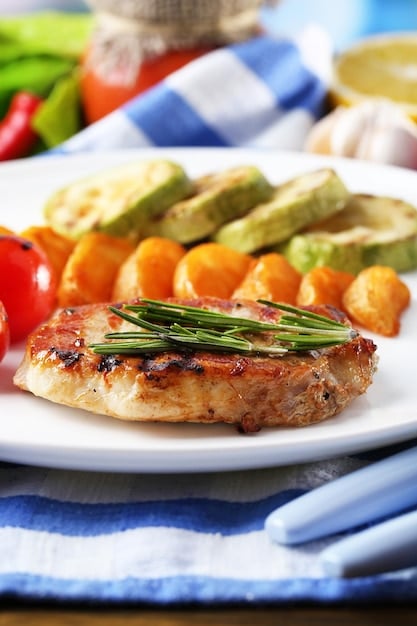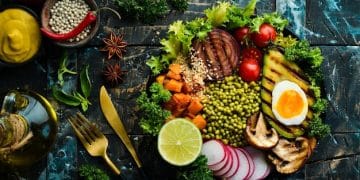Ultimate 7-Day High-Protein Meal Plan for Muscle Growth (2025)

This comprehensive guide provides an updated 7-day high-protein meal plan for muscle growth, focusing on scientifically-backed nutritional strategies to optimize protein intake, calorie balance, and micronutrient support for effective anabolism and recovery in 2025.
Embarking on a journey to sculpted muscle requires more than just lifting weights; it demands a strategic approach to nutrition. This updated The Ultimate 7-Day High-Protein Meal Plan for Muscle Growth: Updated for 2025 serves as your blueprint, meticulously crafted to fuel your body with the essential building blocks it needs. We’ll delve into the science behind protein intake, meal timing, and nutrient density, ensuring every bite contributes to your pursuit of strength and definition. Get ready to transform your physique with powerful, purposeful eating.
The Science Behind High-Protein Diets for Muscle Growth
Understanding why a high-protein diet is crucial for muscle development transcends mere anecdotal evidence; it’s rooted in fundamental biological processes. Proteins are the macro-nutrients composed of amino acids, often referred to as the “building blocks” of life. When you engage in resistance training, your muscle fibers experience micro-tears. The body then uses amino acids from dietary protein to repair these tears, making the muscle fibers thicker and stronger—a process known as muscle protein synthesis (MPS).
Beyond the direct repair mechanism, protein also plays a vital role in hormone production, immune function, and enzyme activity, all of which indirectly support muscle growth and overall athletic performance. A high intake ensures a constant supply of these essential amino acids, particularly branched-chain amino acids (BCAAs) like leucine, isoleucine, and valine, which are critical triggers for MPS.
Recommended Protein Intake and Sources
For individuals actively seeking muscle growth, the consensus among sports nutritionists typically ranges from 1.6 to 2.2 grams of protein per kilogram of body weight daily. This range provides an optimal balance for stimulating MPS without overstressing the kidneys in healthy individuals. However, individual needs can vary based on training intensity, body composition goals, and activity levels.
The quality of protein sources also significantly impacts their effectiveness. Complete proteins, which contain all nine essential amino acids, are superior. Integrating a variety of these sources throughout your day ensures a comprehensive amino acid profile.
- Lean Meats: Chicken breast, turkey, lean beef, pork loin are excellent sources of complete protein.
- Fish and Seafood: Salmon, tuna, cod, and shrimp offer high-quality protein along with beneficial omega-3 fatty acids.
- Eggs and Dairy: Eggs are a complete protein powerhouse, while Greek yogurt, cottage cheese, and milk provide casein and whey, slow and fast-digesting proteins respectively.
- Plant-Based Proteins: For vegetarians and vegans, a combination of legumes (lentils, beans), tofu, tempeh, quinoa, and protein powders (pea, soy, rice) can also meet daily protein requirements.
Moreover, timing your protein intake, particularly around your workouts, can amplify its benefits. Consuming protein before and after exercise helps to prepare muscles for the upcoming strain and kickstarts the repair process, respectively. Distributing protein evenly throughout the day, aiming for 20-40 grams per meal, is also a highly effective strategy to maintain elevated MPS levels.
Crafting Your 7-Day High-Protein Meal Plan: Foundational Principles
Designing an effective meal plan for muscle growth goes beyond simply loading up on protein; it requires a balanced approach to all macronutrients, meticulous attention to micronutrients, and an understanding of energy balance. Our Ultimate 7-Day High-Protein Meal Plan for Muscle Growth: Updated for 2025 incorporates these principles to maximize results and ensure sustainable progress.
First and foremost, caloric intake must be adequate. To build muscle, you need to be in a slight caloric surplus, meaning you consume more calories than you burn. This surplus provides the necessary energy for muscle protein synthesis and recovery. However, an excessive surplus can lead to unwanted fat gain, so balance is key. Calculating your total daily energy expenditure (TDEE) and adding 250-500 calories is a common starting point for a lean bulk.
Macronutrient Distribution and Meal Timing
While protein is paramount, carbohydrates and fats play equally critical, albeit different, roles. Carbohydrates are your primary energy source, fueling intense workouts and replenishing glycogen stores. Aim for complex carbohydrates like oats, brown rice, quinoa, and whole-grain breads to provide sustained energy. Fats, both monounsaturated and polyunsaturated, are essential for hormone production, nutrient absorption, and overall health. Sources like avocados, nuts, seeds, and olive oil are highly recommended.
- Protein: 1.6-2.2 g per kg of body weight (approx. 25-35% of total calories).
- Carbohydrates: 4-6 g per kg of body weight (approx. 45-55% of total calories).
- Fats: 0.5-1 g per kg of body weight (approx. 20-30% of total calories).
Meal timing also optimization for muscle growth. Eating every 3-4 hours helps maintain a positive nitrogen balance, promoting continuous MPS. Small, frequent meals prevent long periods of fasting, which can put the body in a catabolic state (muscle breakdown). Incorporating protein and carbohydrates around your training window (pre and post-workout) is particularly beneficial for performance and recovery.
Hydration and Micronutrients
Often overlooked, sufficient hydration is non-negotiable for muscle growth and overall health. Water facilitates nutrient transport, regulates body temperature, and is crucial for muscle contraction. Aim for at least 3-4 liters of water daily, increasing intake during intense training sessions. Electrolytes, lost through sweat, should also be replenished, which often happens naturally through a balanced diet.
Lest we forget the micronutrients – vitamins and minerals. These unsung heroes facilitate countless metabolic processes, including energy production, muscle function, and antioxidant defense. A diet rich in fruits, vegetables, and whole grains will naturally provide a spectrum of micronutrients; however, some individuals may benefit from targeted supplementation, especially for vitamin D and magnesium, which are common deficiencies relevant to athletic performance.
Your Updated 7-Day High-Protein Meal Plan (2025 Edition)
This meal plan is designed to be adaptable and should be adjusted based on your individual caloric and macronutrient needs. The portions provided are general guidelines. Ensure you’re consuming enough calories for muscle growth, as discussed earlier. This structure provides a framework for healthy, high-protein eating; feel free to swap meals and snacks based on your preferences, always ensuring nutritional balance.

Day 1: Kickstarting Your Week
- Breakfast: Scrambled eggs (3 large) with spinach and a slice of whole-wheat toast.
- Snack 1: Greek yogurt (1 cup) with a handful of almonds.
- Lunch: Grilled chicken salad with mixed greens, avocado, and a light vinaigrette.
- Snack 2: Protein shake (whey or plant-based) with a banana.
- Dinner: Baked salmon (6 oz) with quinoa (1 cup cooked) and steamed broccoli.
Day 2: Fueling Your Progress
- Breakfast: Overnight oats (1/2 cup dry oats) with protein powder (1 scoop), berries, and chia seeds.
- Snack 1: Cottage cheese (1 cup) with sliced bell peppers.
- Lunch: Turkey and veggie wrap (whole-grain tortilla) with hummus.
- Snack 2: Hard-boiled eggs (2) and an apple.
- Dinner: Lean ground beef stir-fry (6 oz) with brown rice (1 cup cooked) and mixed vegetables.
Day 3: Mid-Week Power
- Breakfast: Protein pancakes (2-3) made with protein powder and egg whites, topped with a small amount of sugar-free syrup.
- Snack 1: Edamame (1 cup, shelled).
- Lunch: Leftover lean ground beef stir-fry.
- Snack 2: Rice cakes (2) with peanut butter.
- Dinner: Chicken breast (6 oz) stuffed with mozzarella and sun-dried tomatoes, served with sweet potato (1 medium) and green beans.
Day 4: Peak Performance Fuel
- Breakfast: Smoothie: protein powder, spinach, banana, almond milk.
- Snack 1: Tuna (canned in water, 5 oz) on whole-grain crackers.
- Lunch: Large mixed green salad with chickpeas (1/2 cup), feta cheese, and grilled shrimp (5 oz).
- Snack 2: Greek yogurt with a sprinkle of walnuts.
- Dinner: Pork tenderloin (6 oz) with roasted asparagus and a small baked potato.
Day 5: Consistency is Key
- Breakfast: Tofu scramble (5 oz firm tofu) with mixed vegetables and a dash of turmeric.
- Snack 1: Beef jerky (lean, 1 oz).
- Lunch: Leftover large mixed green salad with chickpeas and grilled shrimp.
- Snack 2: Protein bar (low in sugar).
- Dinner: Lentil soup (2 cups) with a side of whole-grain bread and a small side salad.
Day 6: Weekend Warrior Nutrition
- Breakfast: Whole-wheat waffles (2) topped with Greek yogurt and berries.
- Snack 1: Handful of mixed nuts (almonds, cashews).
- Lunch: Chicken (5 oz) and vegetable skewers with a side of couscous.
- Snack 2: Hard-boiled eggs (2).
- Dinner: Baked cod (6 oz) with roasted root vegetables (carrots, parsnips).
Day 7: Recover and Reload
- Breakfast: Omelet (3 eggs) with mushrooms, onions, and a sprinkle of low-fat cheese.
- Snack 1: Apple slices with almond butter.
- Lunch: Leftover baked cod with roasted root vegetables.
- Snack 2: Protein shake.
- Dinner: Chili (homemade, with lean ground turkey or beans) and a small whole-grain roll.
Optimizing Your Meal Plan: Adjustments and Considerations
A “one-size-fits-all” approach rarely yields optimal results in nutrition, especially when targeting specific goals like muscle growth. While the provided 7-day meal plan offers a solid foundation, fine-tuning it to your individual needs, preferences, and lifestyle is crucial. This involves considering your activity level, metabolic rate, dietary restrictions, and even culinary skills.
Caloric and Macronutrient Adjustments
Your initial caloric surplus should be monitored closely. If you’re gaining weight too rapidly (e.g., more than 1-2 pounds per week for an experienced lifter), you might be gaining excess fat. Conversely, if no significant muscle or weight gain occurs, your caloric intake might be too low. Adjusting your portions, particularly of carbohydrates and fats, by 10-15% can help dial in your optimal intake. For instance, increasing the serving size of rice or adding an extra tablespoon of olive oil can subtly boost calories without drastic changes.
Macronutrient ratios can also be tweaked. Some individuals thrive on slightly higher carbohydrate intake for intense training, while others might prefer a slightly increased fat intake for satiety and prolonged energy. Listen to your body: how do you feel during workouts? How is your recovery? These are valuable indicators for adjustment.
Ingredient Swaps and Dietary Restrictions
Variety is key to preventing boredom and ensuring a broad spectrum of micronutrients. Don’t feel bound to the exact ingredients listed. For example, if you dislike salmon, cod or mackerel are excellent protein substitutes. Can’t tolerate dairy? Opt for plant-based yogurts and milks, ensuring they are fortified with calcium and vitamin D.
- Vegetarian/Vegan Adaptations: Tofu, tempeh, lentils, beans, and high-quality plant-based protein powders can replace animal proteins. Ensure combinations of plant sources to achieve complete amino acid profiles.
- Allergies: If you have allergies (e.g., to nuts, gluten), carefully select alternative ingredients. Gluten-free oats, rice pasta, and seed butters are viable options.
- “Clean Eating” Principles: Focus on whole, unprocessed foods. Minimize added sugars, excessive sodium, and artificial ingredients. This updated plan emphasizes fresh and minimally processed components to ensure you’re getting nutrient-dense meals.
Consider meal prepping. Dedicate a few hours one day a week to cook larger batches of staples like grilled chicken, cooked quinoa, and roasted vegetables. This saves time during busy weekdays and helps ensure you stick to your plan consistently. Preparing healthy snacks in advance also prevents impulsive, less nutritious choices.
Beyond Food: Lifestyle Factors for Muscle Growth (2025 Insights)
While a meticulously planned high-protein diet forms the bedrock of muscle growth, it’s merely one pillar in a multi-faceted construct. Achieving peak muscle development in 2025 demands an integrated approach that also prioritizes training, recovery, and mental well-being. Nutrition amplifies the effects of these other critical elements, but it cannot compensate for their absence.
Strategic Training and Progressive Overload
Your diet fuels your training, but your training is what directly stimulates muscle adaptation. This means consistently challenging your muscles through progressive overload—gradually increasing the demands placed on your musculoskeletal system. This can involve lifting heavier weights, performing more repetitions, increasing training volume, or shortening rest periods. Without a structured, progressively challenging workout regimen, even the most perfect diet won’t lead to significant muscle gains.
The type of training also matters. Resistance training (weightlifting, bodyweight exercises) is paramount for hypertrophy (muscle growth). Incorporating a mix of compound movements (squats, deadlifts, bench press) and isolation exercises helps effectively target all major muscle groups. Consider working with a certified personal trainer to establish a safe and effective program tailored to your goals and current fitness level.

The Crucial Role of Sleep and Recovery
Muscle growth doesn’t happen in the gym; it happens during recovery, particularly during sleep. When you sleep, your body releases growth hormone, which is essential for muscle repair and growth. Aim for 7-9 hours of quality sleep per night. Poor sleep can elevate cortisol levels (a catabolic hormone) and reduce testosterone (an anabolic hormone), hindering your progress.
Active recovery methods, such as light stretching, foam rolling, or low-intensity cardio, can also improve blood flow to muscles and aid in repair. Listening to your body and incorporating rest days are as important as the training itself. Overtraining can lead to plateaus, increased risk of injury, and prolonged recovery times, ultimately slowing your progress.
Mindset and Consistency
Building muscle is a marathon, not a sprint. Consistency in both your diet and training is far more impactful than intermittent bursts of perfection. There will be days when motivation wanes, or external factors disrupt your routine. However, the ability to return to your plan and maintain discipline over the long term is what separates success from stagnation.
- Set Realistic Goals: Understand that muscle growth is a gradual process. Celebrate small victories and focus on sustainable habits.
- Track Progress: Monitor your weight, body measurements, strength gains, and even how your clothes fit. This feedback can be incredibly motivating and help you make informed adjustments.
- Seek Support: Connect with a community, a coach, or a workout partner. Shared goals and mutual encouragement can provide invaluable support.
In 2025, the synergy between a high-protein diet, strategic training, adequate recovery, and a positive mindset is understood to be essential for maximizing muscle growth. Embrace this holistic approach, and you’ll not only build a stronger physique but also cultivate a healthier, more resilient lifestyle.
Advanced Strategies and Supplementation in 2025
As we advance into 2025, the landscape of muscle growth optimization continues to evolve, incorporating more sophisticated strategies in both nutrition and supplementation. While the foundational principles of a high-protein diet, consistent training, and adequate recovery remain paramount, certain advanced tactics can further refine your results.
Timing and Type of Protein
Beyond simply meeting your daily protein targets, consider the strategic timing and type of protein to maximize muscle protein synthesis (MPS). Faster-digesting proteins like whey are ideal post-workout, rapidly delivering amino acids to depleted muscles. Slower-digesting proteins such as casein, found in cottage cheese or casein protein powder, are excellent for nighttime consumption, providing a sustained release of amino acids throughout sleep, thus preventing catabolism.
Many athletes are now exploring a blend of protein types, consuming both fast and slow-digesting proteins at various times of the day to ensure a constant positive nitrogen balance. This nuanced approach helps keep amino acid levels elevated, creating an optimal environment for muscle repair and growth around the clock.
Beyond Macros: Micronutrient Deep Dive
The role of micronutrients in muscle growth is gaining more recognition. Vitamins and minerals are not just for general health; they actively participate in metabolic pathways critical for energy production, hormone synthesis, and muscle function. For instance, magnesium is vital for muscle contraction and nerve function, zinc plays a role in testosterone production, and B vitamins are crucial for energy metabolism. Ensuring adequate intake of these micronutrients, possibly through a high-quality multivitamin or specific supplements tailored to detected deficiencies, can remove bottlenecks hindering your progress.
Furthermore, attention to anti-inflammatory micronutrients, found in brightly colored fruits and vegetables, can aid in faster recovery by reducing exercise-induced inflammation. This means a quicker return to training and reduced muscle soreness, allowing for greater consistency in your regimen.
Smart Supplementation: What to Consider in 2025
The supplement market is vast, but only a few have consistent scientific backing for muscle growth:
- Creatine Monohydrate: Remains the gold standard. It enhances strength, power, and muscle mass by increasing ATP regeneration during high-intensity exercise.
- Whey Protein: A convenient and effective way to increase protein intake, particularly around workouts.
- Beta-Alanine: Can improve muscular endurance by buffering lactic acid, allowing for more reps per set.
- Essential Amino Acids (EAAs) / Branched-Chain Amino Acids (BCAAs): While a complete protein diet usually provides sufficient EAAs, supplementation can be useful during fasted states or for those with lower protein intake from whole foods. Leucine is particularly important for triggering MPS.
- Vitamin D and Omega-3 Fatty Acids: Supports overall health, hormone function, and inflammation reduction, indirectly aiding muscle growth and recovery.
Before introducing any new supplement, and certainly before making significant dietary changes, consulting with a healthcare professional or a registered dietitian is always recommended. This ensures that any strategy aligns with your individual health profile and goals, and that supplements don’t interact negatively with existing conditions or medications. The updated plan for 2025 integrates both time-tested principles and the latest scientific understanding to provide a truly comprehensive approach.
Overcoming Challenges and Sustaining Progress
The journey to building significant muscle is rarely a straight line. Plateaus, lack of motivation, and the demands of daily life can all pose challenges. Successfully navigating these obstacles is crucial for sustaining long-term progress and achieving your physique goals. The Ultimate 7-Day High-Protein Meal Plan for Muscle Growth: Updated for 2025 is a powerful tool, but its effectiveness is amplified by your ability to adapt and persevere.
Breaking Through Plateaus
One of the most frustrating experiences in muscle building is hitting a plateau where progress stagnates despite consistent effort. When this happens with your diet, it’s often a sign to reassess your caloric and macronutrient intake. Perhaps your body has adapted to your current intake, or your increased muscle mass now requires more fuel. A common strategy is to increase your total daily calories by a small margin (e.g., 100-200 calories per day) from carbohydrates or fats for a week or two, then re-evaluate. Varying your protein sources can also ensure you’re getting a broad spectrum of amino acids.
Aside from nutrition, plateaus in training may require a change in your workout routine, incorporating new exercises, altering rep ranges, or implementing advanced training techniques like drop sets or supersets. The body thrives on novelty, and a systematic shock to the system, both nutritionally and gravitationally, can kickstart new growth.
Managing Cravings and Adherence
Even with the best intentions, cravings for less nutritious foods can derail your plan. The key to managing these is not necessarily outright deprivation, but intelligent moderation and strategic planning. Incorporating a “flexible dieting” approach, where a small percentage (e.g., 10-20%) of your daily calories comes from more enjoyable, less “clean” foods, can enhance adherence without significant detrimental effects on your progress. This approach fosters a healthier relationship with food and prevents the binge-restrict cycle.
Furthermore, ensure your high-protein meal plan is enjoyable. Experiment with different recipes and spices. The 2025 update emphasizes palatable, satisfying meals that make adherence easier. Preparing meals you genuinely look forward to eating is a cornerstone of long-term success. If you’re consistently eating bland food, the likelihood of straying from your plan increases dramatically.
Long-Term Mindset and Lifestyle Integration
Muscle growth is not a seasonal endeavor; it’s a lifestyle. Integrating healthy eating habits into your daily routine, rather than viewing them as a temporary diet, is fundamental for sustaining results. This means focusing on education—understanding why certain foods benefit your body—and cultivating mindful eating practices. Learning to distinguish between physical hunger and emotional eating is a powerful skill. The updated plan considers long-term sustainability by promoting balanced nutrition over extreme restrictions.
By proactively addressing challenges and viewing your muscle-building journey as an ongoing process of learning and adaptation, you can ensure continuous progress and maintain a muscular, healthy physique for years to come. Remember, every challenge is an opportunity to refine your approach and deepen your understanding of your own body.
Conclusion: The Path Forward for Muscle Growth in 2025
To summarize, the pursuit of muscle growth in 2025 involves a holistic, evidence-based approach that centers on a high-protein diet, meticulous nutrient timing, and a deep understanding of caloric balance. The Ultimate 7-Day High-Protein Meal Plan for Muscle Growth: Updated for 2025 provides a robust framework, but its true power lies in its adaptability to individual needs and lifestyle. Beyond the plate, consistent, challenging training, adequate sleep, and unwavering consistency are equally vital, forming an interconnected system for optimal results. Embrace this comprehensive strategy, and you’ll find yourself well-equipped to sculpt a stronger, more resilient physique, not just for the immediate future, but for the long term.
| Key Point | Brief Description |
|---|---|
| 💪 Protein Intake | Aim for 1.6-2.2g/kg body weight daily from diverse sources. |
| 🍽️ Caloric Surplus | Maintain a slight surplus (250-500 calories) for effective muscle gain. |
| 💧 Hydration & Micros | Crucial for all bodily functions and nutrient transport. |
| 😴 Recovery & Sleep | 7-9 hours essential for hormone release and muscle repair. |
Frequently Asked Questions About Muscle Growth Meal Plans
While total daily protein intake is most critical, strategic protein timing can optimize results. Consuming protein (especially whey) before and after workouts helps to maximize muscle protein synthesis and reduce muscle breakdown. Distributing protein evenly throughout the day, aiming for 20-40 grams per meal, also maintains elevated amino acid levels for continuous muscle repair.
Absolutely. Building muscle on a vegetarian or vegan diet is entirely feasible with careful planning. Focus on diverse plant-based protein sources like tofu, tempeh, lentils, beans, edamame, and quinoa. Combining different plant proteins throughout the day ensures you get all essential amino acids. Plant-based protein powders can also be a valuable supplement.
Not gaining weight indicates you might not be in a sufficient caloric surplus. Re-evaluate your total daily energy expenditure and gradually increase your calorie intake by 200-300 calories per day, primarily from complex carbohydrates and healthy fats. Monitor your weight and adjust further until you achieve a steady gain of 0.5-1 pound per week for optimal muscle growth.
Supplements are not strictly necessary but can be beneficial. A solid diet and consistent training are the foundations. However, supplements like creatine monohydrate and whey protein have strong scientific backing for enhancing performance and aiding muscle growth. Essential amino acids (EAAs) or branched-chain amino acids (BCAAs) could also support recovery, though often sufficiently obtained from a high-protein diet.
This meal plan is a template. Adjust it by swapping ingredients based on your preferences, allergies, and dietary restrictions. For instance, if allergic to nuts, use seeds. If sensitive to dairy, opt for lactose-free or plant-based alternatives. Always ensure that substitutions maintain a similar macronutrient profile and provide essential micronutrients. Consulting a dietitian can offer personalized guidance.





